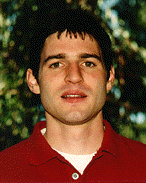X-ray studies of I-kappa-B-alpha and I-kappa-B / NF-kappa-B complexes
Tom Huxford
Appointment Period: 1996-1998, Grant Years: [12,13]
 In order for cells to function properly and survive, they require mechanisms for rapid response to stimuli. Chemical signals at cell surfaces are passed across the cell membrane and into the cell's nucleus. The genes that encode the molecular response to the original signal are then activated for transcription. The transcription factor protein NF-kappa-B is a key moderator in this response pathway.
In order for cells to function properly and survive, they require mechanisms for rapid response to stimuli. Chemical signals at cell surfaces are passed across the cell membrane and into the cell's nucleus. The genes that encode the molecular response to the original signal are then activated for transcription. The transcription factor protein NF-kappa-B is a key moderator in this response pathway.
In its resting state, NF-kappa-B exists in complex with an inhibitor protein, I-kappa-B-alpha. As a chemical signal is relayed toward the cell's nucleus, I-kappa-B-alpha becomes phosphorylated and ubiquitinated. This marks the protein for dissociation from NF-kappa-B and proteolytic degradation. Newly uncomplexed NF-kappa-B then translocates across the nucleus and signals for the transcription of response genes. This mechanism has become the focus of attention as it has been implicated as a vital player in immune responses, transcription of genes by the HIV virus, and in the development several cancers, especially of immune cells. Structural understanding of the inhibition of NF-kappa-B by its natural inhibitor, I-kappa-B-alpha, will be vital in developing methods to control these events at the transcriptional level.
I have been fortunate to be able to participate in the successful large-scale purification and structural characterization of several members of the NF-kappa-B family. This research has opened up many exciting avenues of research for multiple investigators, including a deep understanding of protein-protein interactions among family members, mechanisms of binding to DNA, and the potential design of therapeutic agents targeting these proteins.
PUBLICATIONS (resulting from this training, and some recent ones)
Huang DB, Huxford T, Chen YQ, Ghosh G. (1997) The role of DNA in the mechanism of NF-kappaB dimer formation: crystal structures of the dimerization domains of the p50 and p65 subunits. Structure 5:1427-1436.
Huxford T, Huang DB, Malek S, Ghosh G. (1998) The crystal structure of the IkappaBalpha/NF-kappaB complex reveals mechanisms of NF-kappaB inactivation. Cell 95:759-770.
Malek S, Huxford T, Ghosh G. (1998) IkBa functions through direct contacts with the nuclear localization signals and the DNA binding sequences of NF-kappaB. J Biol Chem. 273:25427-25435.
Huxford T, Malek S, Ghosh G. (1999) Structure and mechanism in NF-kappaB/IkappaB signaling. Cold Spring Harbor Symp Quant Biol. 64:533-540.
Ghosh G, Huang DB, Huxford T. (1999) Structural insights into NF-kappaB/IkappaB signaling. Gene Therapy and Molecular Biology 5:75-82.
Huxford T, Malek S, Ghosh G. (2000) Preparation and crystallization of dynamic NF-kappaB/IkappaB complexes. J Biol Chem. 275:32800-32806.
Phelps C, Sengchanthalangsy LL, Huxford T, Ghosh G. (2000) Mechanism of IkappaBalpha binding to NF-kappaB dimers. J Biol Chem. 275:29840-29846.
Malek S, Chen Y, Huxford T, Ghosh G. (2001) IkappaBbeta, but not IkappaBalpha, functions as a classical cytoplasmic inhibitor of NF-kappaB dimers by masking both NF-kappaB nuclear localization sequences in resting cells. J Biol Chem. 276:45225-45235.
Huxford T, Mishler D, Phelps CB, Chen Y, Sengchanthalangsy LL, Reeves R, Hughes CA, Komives EA, Ghosh G. (2002) Solvent exposed non-contacting amino acids play a critical role in NF-kappaB/IkappaBalpha complex formation. J Mol Biol. 324:587-597.
Huxford T, Ghosh G. (2002) IkappaB proteins. In, Wiley Encyclopedia of Molecular Medicine, John Wiley & Sons, Inc. 1712-1716. Wiley
Malek S, Huang DB, Chen Y, Huxford T, Ghosh S, Ghosh G. (2003). X-ray crystal structure of an IkappaBbeta/NF-kappaB p65 homodimer complex. J Biol Chem. 278:23094-23100.
Ghosh G, Huang DB, Huxford T. (2004) Molecular mimicry of the NF-kappaB DNA target site by a selected RNA aptamer. Curr Opin Struct Biol. 14:21-27.
Hughes CA, Bergqvist S, Huxford T, Ghosh G, Komives EA. (2004) Biophysical characterization of the free IkappaBalpha ankyrin repeat domain in solution. Protein Sci. 13:1767-1777.
Huxford T, Ghosh G. (2005) Inhibition of transcription factor NF-kappaB activation by kappaB-Ras. Methods Enzymol. 407:527-534.
Huxford T, Ghosh G. (2006) Structural analysis of NF-kappaB and IkappaB proteins. In, NF-kappaB/Rel Transcription Factor Family. Edited by Hsiou-Chi Liou: Landes Bioscience, Georgetown, Texas 1-11. Landes Bioscience
Huxford T, Moorthy AK, Ghosh G. (2006) kappaB-Ras: a small GTPase that influences NF-kappaB signaling. In, RAS Family GTPases. Protein and Cell Regulation series, Volume 4. Edited by Channing J. Der. Springer Science, Dordecht, The Netherlands 341-352.
Moorthy AK, Huxford T, Ghosh G. (2007) Structural aspects of NF-kappaB and IkappaB proteins. In, Handbook of transcription factor NF-kappaB. Edited by Sankar Ghosh. Taylor and Francis CRC Press, Boca Raton, Florida 9-24.
 In order for cells to function properly and survive, they require mechanisms for rapid response to stimuli. Chemical signals at cell surfaces are passed across the cell membrane and into the cell's nucleus. The genes that encode the molecular response to the original signal are then activated for transcription. The transcription factor protein NF-kappa-B is a key moderator in this response pathway.
In order for cells to function properly and survive, they require mechanisms for rapid response to stimuli. Chemical signals at cell surfaces are passed across the cell membrane and into the cell's nucleus. The genes that encode the molecular response to the original signal are then activated for transcription. The transcription factor protein NF-kappa-B is a key moderator in this response pathway.